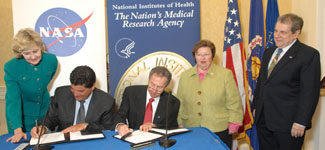| |
 |
|
|
|
|
| |
NIH director Dr. Elias Zerhouni and NASA administrator Dr. Michael D. Griffin sign an agreement making U.S. resources on the International Space Station available for NIH-funded research. Sen. Kay Bailey Hutchison (l), Sen. Barbara Mikulski and NIAMS director Dr. Stephen Katz witness the occasion. |
|
Said Zerhouni, “I am extremely pleased that this collaborative effort is moving forward. The International Space Station provides a unique environment where researchers can explore fundamental questions about human health issues, including how the body heals itself, fights infection or develops diseases such as cancer or osteoporosis.” NASA’s Griffin remarked, “Not only will the station help in our efforts to explore the moon, Mars and beyond, its resources also can be applied for a much broader purpose—improving human health.”
NIAMS director Dr. Stephen Katz, who serves as NIH liaison to NASA and was one of the chief architects of the agreement, also emphasized
the potential for research on the ISS. “The agreement signals to researchers the availability of a remarkable platform on which to conduct experiments. It will encourage the nation’s biomedical
research community to develop innovative
hypotheses that, when tested, will promote new understanding of fundamental physiology and benefit life on Earth.”
Also attending the ceremony to demonstrate their support for the NIH-NASA partnership were Senators Kay Bailey Hutchison (R-TX), Barbara Mikulski (D-MD) and Bill Nelson (D-FL). Hutchison, who was responsible for legislation
that formally designated the U.S. portion
of the ISS as a national laboratory, noted that “because of U.S. leadership, the ISS is becoming a global center for groundbreaking scientific research.”
The ceremony also included presentations by NICHD scientist Dr. Joshua Zimmerberg and former astronaut Col. Carl Walz (USAF, Ret.). The two collaborated on ISS research related to the human immune response almost 6 years ago; Zimmerberg’s laboratory continues to work closely with NASA on designing experiments for other ISS missions.
As part of the agreement, NIH will publicize the availability of the ISS as an environment that can accommodate a variety of experimental
approaches and can address a range of health-related research questions. NASA, in turn, will advise investigators on implementing NIH-funded projects, including the training of NASA astronauts who will conduct the experiments
in space.
For more information on the NIH–NASA partnership,
visit www.niams.nih.gov/News_and_Events/NIH_NASA_Activities/default.asp. 